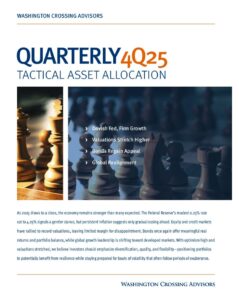Insight & Commentaries
We are entering the fifth year of recovery, with most of the data improved since last summer’s slump. Large amounts of deficit-financed spending and central bank liquidity are contributing to economic activity and lifting asset values. With the stock market back to pre-crisis levels, we want to look at how various “pillars” of the recovery are holding up.
Our analysis of incoming data suggests a decent start to 2013. These observations form the basis for our forecast as we start the year. Even though a policy misstep could always derail the economy, we expect a positive environment for investors because valuations appear reasonable and economic fundamentals are gradually improving.
A new phase of the economic recovery has begun. The slumping economy and cratering financial markets that greeted President Obama in 2008 are, thankfully, no longer with us. Today, we are in the third year of economic recovery, financial markets have substantially recovered, house prices are rising again, and employment rolls are expanding. As the crisis phase passes into history and the economy continues to grow, pressure to address deficits and debt will also grow.
With August now in the history books, we note that the downtrend in fundamental data appears to have been arrested and that a bottoming process is likely underway. Specifically, we saw encouraging signs in August that the U.S. consumer continues to spend in the face of higher gasoline prices. Automobile sales, for example, rose to a 14.46 million annualized rate last month, and chain store sales accelerated to a 2.6% year-over-year growth rate. Global manufacturing surveys also showed some modest improvement during the month, despite remaining near depressed levels.
Unless Congress acts, today’s tax rate on dividends is set to increase next year when the Bush tax cuts expire. This commentary explores the potential for a tax increase and what it might mean for investors.
Our posture has been a bit more cautious since our Fundamental barometer began to head south a few weeks ago. However, we are ever watchful for signs of improvement in the landscape. The past few trading sessions has shown at least a temporary willingness for global investors to let their hair down, throw caution to the wind, and go long equities. Our assessment is a bit more sober, but we are paying attention to what the data is telling us.
We reflect on an updated World Bank outlook for improving growth and refine our measurements for foreign conditions. We believe that Europe will ultimately seek to maintain the status quo and proceed toward further integration over fragmentation. Politics and policy response remain wild cards as Greece heads to the polls this weekend, the Federal Reserve meets June 19-20, and the European Central Bank meets on July 6.
A stop-start growth pattern since 2009 makes this recovery feel vastly different than past recoveries. Large deficits and larger debts are major factors behind the uneven pace of recovery. Rather than accelerating smoothly into the economic fast lane, the journey away from the financial crisis seems more like being stuck in traffic. Forward progress continues, but progress is frustratingly slow.
This report discusses current recommended allocations in light of evolving fundamental conditions. The report also includes an update on the WCA Fundamental Conditions Index along with a longer-term view of the index. Recommended portfolio allocations for different investor types are also detailed.
Friday’s April employment report was a dud in the eyes of Wall Street, but a closer look reveals positives. The number of jobs created was less than expected (115,000 jobs added versus expectations of 160,000), but the direction, source, and composition of the changes tell a different story.



